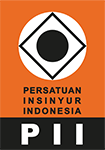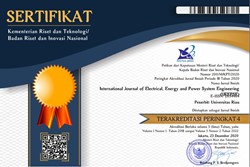Application of Rainwater Harvesting Technology to Supply Sustainable Domestic Water
Abstract
Rainwater harvesting that is good and right by the needs of household clean water is one of the problems for the people in the islands in Indonesia, especially Merbau Island which is located in the Kepulauan Meranti Regency, Riau Province. The only source of clean water that can be enjoyed easily and cheaply is rainwater. Rainfall on Merbau Island ranges between 2.000 – 4.000 mm per year which is classified as moderate. A survey of 100 randomly selected people was conducted, with a questionnaire containing components for rainwater harvesting (RWH) and other core questions. If available rainfall is used optimally, the need for clean water on the island can be met. Calculation of rainwater for cooking, drinking and washing needs is estimated to be around 15 lpcd. The data obtained is rainfall in 2016 with a total rainfall of 1,754 mm, roof storage area of 36 m2, and the type of roof used is zinc. Rain cycle V2 simulation produces a 3 m3 volume rainwater storage tank, with a construction cost of Rp. 10,365,000. This tank can meet the needs of clean water for five family members for a year.
References
[1] Ngigi, S.N, "Rain water harvesting for Improved Food Security", Promoting Technologies in the Greater Horn of Africa. Greater Horn of Africa Rainwater Partnership (GHARP). Kenya Rainwater Association (KRA), 2003.
[2] Aroka, N, "Rainwater Harvesting in Rural Kenya: Reliability in a variable and changing climate", Msc thesis, Departement of Physical Geography and Quaternary Geology, Stochholm University, 2010.
[3] Jones, M. P., & Hunt, W. F, "Performance of rainwater harvesting systems in the southeastern United States. Resources", Conservation and Recycling, 54(10), 623-629, 2010.
[4] Burns, M. J., Fletcher, T. D., Walsh, C. J., Ladson, A. R., & Hatt, B. E, "Hydrologic shortcomings of conventional urban stormwater management and opportunities for reform", Landscape and Urban Planning, 105(3), 230-240, 2012.
[5] Steffen, J., Jensen, M., Pomeroy, C.A., and S.J. Burian, "Water supply and stormwater management benefits of residential rainwater harvesting in U.S", cities. J. Amer. Water Res. Assoc, 49(4), 810-824, 2013.
[6] Ward, S., Memon, F. A., & Butler, D, "Performance of a large building rainwater harvesting system", Water research, 46(16), 5127-5134, 2012.
[7] Opare, S, "Rainwater harvesting: an option for sustainable rural water supply in Ghana", GeoJournal 77:695-705, 2012.
[8] Che-Ani A.I, Shaari N, A. Sairi, M.F.M. Zain, M.M. Tahir. (2009). Rainwater Harvesting as an Alternative Water Supply in the Future, European Journal of Scientific Research ISSN 1450-216X. Vol.34 No.1.pp.132-140.
[9] Ngigi, S.N, "Optimization of Rainwater Catchment Systems Design Parameters in the Arid and Semiarid Lands of Kenya", Department of Agricultural Engineering University of Nairobi. Nairobi, Kenya, 2003.
[10] Thomas, T, "Domestic water supply using rainwater Harvesting. Building Research & Information", 26(2), 94–10, 2010.
[11] An, KJ. Lam, YF. Hao, S. Morakinyo, TE. & Furumai, H, "Multi-purpose rainwater harvesting for water resource recovery and the cooling effect", Watres xxx, 1- 6, 2015.
[12] Edgar L.V., Andrew, D, "Analysis of a rainwater collection system for domestic water supply in Ringdansen", Norrkoping, Sweden, Building and Environment 40 (9), pp. 174–1184, 2005.
[13] Dagnachew, A,. Marina, B.J,. Brook, L. Geremew, S.G, "Assessing the Potential for Rooftop Rainwater Harvesting from Large Public Institutions", Int. J. Environ. Res. Public Health. 15, 336, 2018.
[14] Shubham, J. Pankaj, T. Siddharth, S. Mehul, S, "Design of Rooftop Rainwater Harvesting Tank for Katpadi Region", Tamil Nadu, SSRG International Journal of Civil Engineering (SSRG-IJCE), volume 2 Issue 7, 2015.
[15] Julius, J.R. Angeline, P. Ravikumar, G, "Rainwater Harvesting (Rwh) - A Review", International Journal of Scientific & Engineering Research, Volume 4, Issue 8, 2013.
[16] Ojwang, R.O,. Dietrich, J,. Anebagilu, P.K,. Beyer, M. Rottensteiner. F, "Rooftop Rainwater Harvesting for Mombasa: Scenario Development with Image Classification and Water Resources Simulation", Water, 9, 359, 2017.
[17] Bhattacharya, S, "Traditional water harvesting structures and sustainable water management in India: A socio-hydrological review", International Letters of Natural Sciences, Vol. 37, pp. 30-38, 2015.
[18] Cain, N.L, "A different Path: The global water crisis and Rainwater Hatvesting", Consilience: The Journal of Sustainable Develompment, 12(1), 147-157, 2014.
[19] Hartung, H., & Rwabambari, C, "Financing mechanisms for roofwater harvesting, An example from Uganda", 13th International Rainwater Catchment Systems Conference Rainwater and Urban Design, Sydney, Australia, 2007.
[20] Profil Pulau Merbau, Kecamatan Pulau Merbau, 2015.
[21] http://www.ppk-kp3k.kkp.go.id/direktori-pulau/index.php/public_c/pulau_info/ 382#gu, 2017.
[22] BWSS III, Data Curah Hujan Stasiun Dumai, 2017.
[23] Gould, J. and Nissen-Petersen, E, "Rainwater Catchment Systems for Domestic Supply", International Technology Publications, London, United Kingdom, 1999.
[24] Roebuck, R, "Raincycle Standar(c) V2. Rainwater Harvesting Hydraulic Simlation & Whole Life Costing Tool", www.SUDSoutions.com, 2015.



















